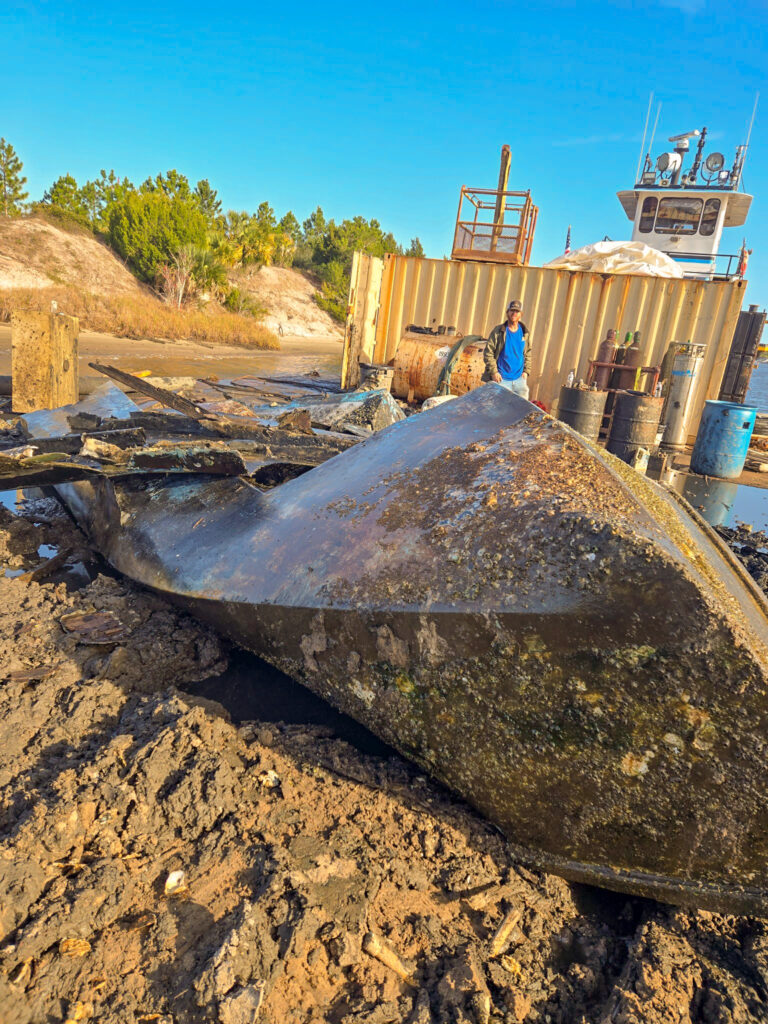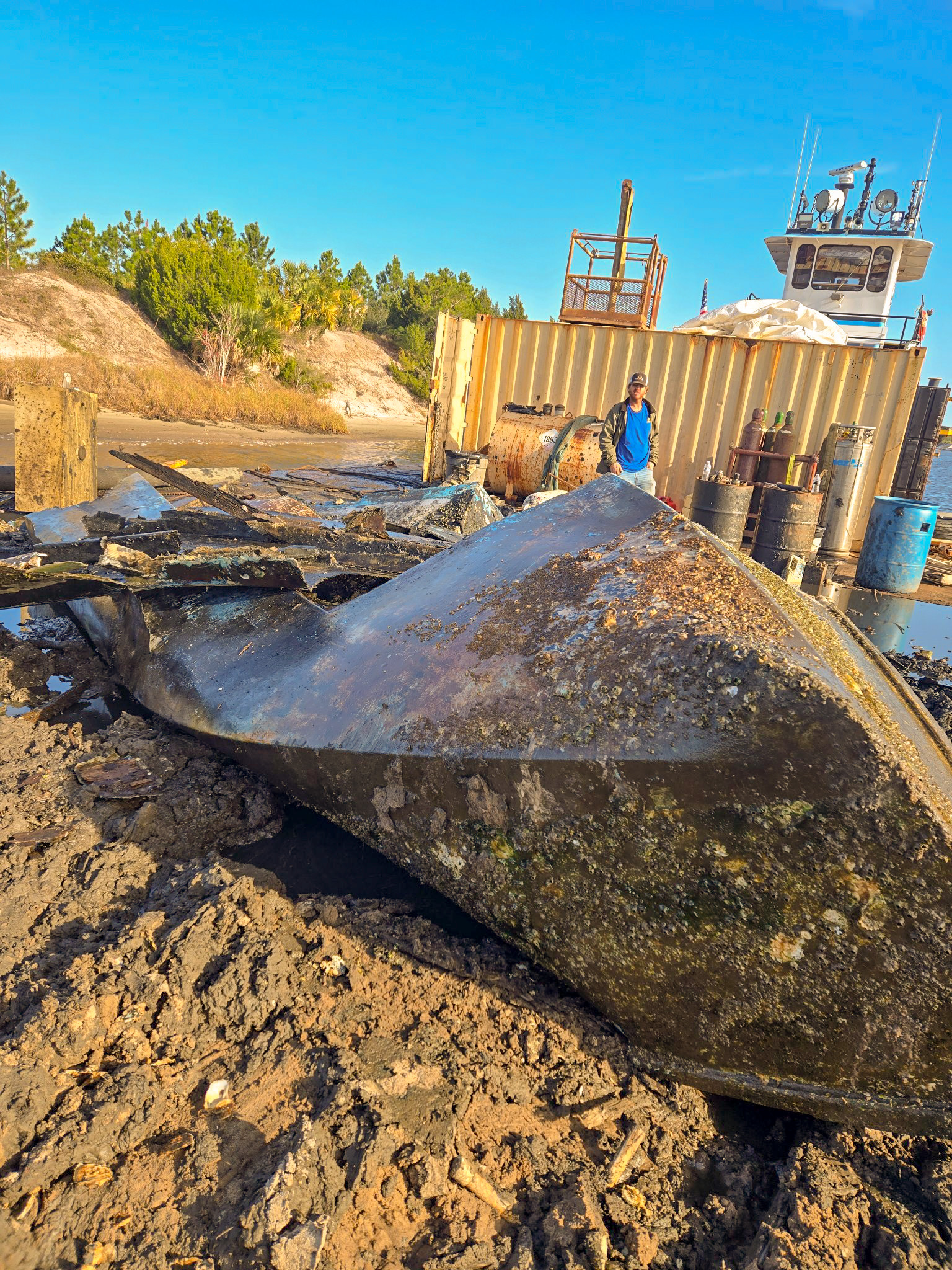FWC clears out derelict vessels from Gulf Canal
Sometimes it was difficult to tell where one wreckage ended and another one began, but for John Salonen, owner of Salonen Marine, Inc. it turned out to be one of the smoothest and most pleasant derelict vessel projects he has had in a while.
On Dec. 17, Salonen Marine completed an eight-day, 10-vessel removal project for the Florida Fish and Wildlife Conservation Commission on 10 vessels that have for years been languishing in the canal.
“It was quite a pleasant area to work, and we got great help,” he said. “It was almost like being on vacation. We rented a small house and it was a pleasant experience all around.
Of course what Salonen pulled out of the water wasn’t so pleasant.
“All of these boats were within a half-mile radius; they were all piled up on the canal bank between the bridge and the Intracoastal,” he said. “Some were down there for more than 30 years, these were not fresh.
“In some areas, the big money counties like Miami-Dade, Palm Beach and Brevard, these (recreational) vessels are there 60 days and put out for bid,” Salonen said. “It depends on the area.”
The FWC’s Division of Law Enforcement’s Boating and Waterways Section is spearheading a multi-year effort to dramatically reduce the backlog of derelict vessels currently on state waters. One method is FWC’s Direct Removal Program, which authorizes it to contract directly with approved contractors to remove derelict vessels from state waters.
FWC officers, the FWC Northwest Region Dive Team and derelict vessel specialists began working on this particular group of derelict vessels in the Gulf Canal in the spring of 2024. They marked and measured each vessel and began the process for removal. The first case for the Gulf Canal project was opened on April 22.
Salonen said there were a couple of surprises as the job was underway, including the discovery of a 74-foot by 24-foot steel barge, larger than expected. “It had to be decades old, completely deteriorated,” he said. “We pulled it out with a hook and then a clamshell bucket which the harder you pull, the harder it grabs.”
In another case, when they were removing a 62-foot cabin motor boat, they found beneath it a wooden hull shrimp boat, an old fishing vessel of similar length.
The rest of the tally, though, according to the FWC records, were a 1974 27-foot Catalina Yacht sailboat with auxiliary power; five open motorboats of lengths ranging from 19 feet to 42 feet; two 39-foot cabin motorboats, and undetermined vessels of 36 feet and 57 feet.
“A lot of them looked like they’ve been cannibalized. Anything of value has been removed, motors, windows, propellers, you can tell they have been scavenged out of them,” Salonen said. “It was almost like a designated dumping ground. They were placed so far enough off the actual channel so they wouldn’t be interfering with the navigation.
“They were so dilapidated, you just fish them out,” he said.
All the debris was carted off to the Gulf County landfill, and tipping fees paid for out of Salonen’s $287,676 contract except for the barge, which however rusty and covered in barnacles, still garnered about $3,000 to $4,000 from a metal recycler in Panama City.
The state gets half of that money, and Salonen pockets the rest. “Twenty tons (at the landfill) would have been $1,400, so it flipped that ticket,” he said.
The derelict vessel adjudication and removal process can include multiple court hearings and court orders to remove a vessel from state waters. Each derelict vessel owner must also be afforded the opportunity for an administrative hearing by the law enforcement agency investigating the case and potential criminal proceedings before the vessels may be authorized for removal.
“Unfortunately, derelict vessels continue to be documented by law enforcement on an ongoing basis. These vessels destroy valuable seagrass resources and endanger marine life. They also threaten human life, safety and property as they drift on or beneath the water’s surface or block navigable waterways, making it a danger to our boating public,” said Maj. Robby Creech, FWC Northwest regional commander. “This was a huge project for Gulf County and a big win for the boating community. I am proud of the local officers who put the work in needed to see this through.”
Now that the removal process is complete, recovering the cost is an ongoing process, as FWC can go after vessel owners to recoup it.
And Salonen, a self-described truck driver, crane operator, tugboat captain and even in his youthful days a diver (before he was “fat and old”) says owners can get themselves in hotter water than they might think.
“It’s like owing taxes, you can’t shake it and it grows interest,” he said.
He said over two decades ago he watched as a vessel abandoned on the St. Charles River had its fuel removed by FWC, which then went on to seize tax refunds each year, and add interest.
“He owes about $1,000 more today,” Salonen said, noting that another owner can’t register a vehicle due to the obligation he has on a derelict vessel.
“They have some tools to go after owners,” he said. “When you got a commercial vessel, if you abandon that, they can throw you in jail for commercial dumping.”
Salonen, whose company operates out of Jacksonville, has a busy schedule on both the Gulf and east coasts of Florida. “It seems like we hardly ever get ahead of it,” he said. “The last two years have been a busy time; there’s simply not enough people with qualifications, whether for FEMA, disaster relief, insurance companies. We could work 24-7 seven days a week and we wouldn’t see the end of the light.”
And there are financial risks in what he does, because unforeseen delays or miscalculations in the scope of the work can eat into his modest profits.
In this most recent case, Salonen usually travels along safe and slow-moving Intracoastal waterways, but because he had a job to do for an insurance company in the Bradenton and Sarasota areas, the crew decided to pack up the 66-foot dump trailer and other heavy equipment they had placed on space rented from Raffield Fisheries, and drive some of it east.
The 165-ton crane, barge and big tug moved down the Intracoastal and then left Apalachicola across the Gulf, where they were exposed for 30 hours in open waters.
‘We’re not set up for heavy ocean crossing,” Salonen said. “We got beat up a little bit. We had 10,000 gallons of diesel on board. It could have been catastrophic, a very nasty oil spill, and that would get into millions of dollars.”
They arrived safely and set about working on the Gulf Coast and cutting across the state at Fort Myers to tackle jobs on the east coast.
He said he’s a big proponent of Florida’s VTIP ( Vessel Turn-In Program), a voluntary program that helps owners dispose of at-risk vessels before they become derelict.
“I think that’s a great program,” he said. “Nintey percent of the pollution happens when the boat sinks, and this eliminates a bunch of costs. It’s a reasonably simple process.
“We talked with South Carolina and Georgia and they’ve been talking about doing a similar process,” Salonen said. “It seems like it would be a win-win.”
FWC said four derelict vessels were removed in Franklin County in 2024, and more are slated for removal in 2025 in both Franklin and Gulf Counties.
“Cleaning Florida’s waterways of derelict vessels is a persistent, ongoing effort, and these vessels are removed as they are identified and investigated properly,” said Ashlee Sklute, FWC spokeswoman.
The public can report violations to 1-888-404-3922, send a text to 847411 (Tip411) with keyword “FWC” followed by the location and any information you can about the violation or submit a tip online at MyFWC.com/WildlifeAlert.








Meet the Editor
David Adlerstein, The Apalachicola Times’ digital editor, started with the news outlet in January 2002 as a reporter.
Prior to then, David Adlerstein began as a newspaperman with a small Boston weekly, after graduating magna cum laude from Brandeis University in Waltham, Massachusetts. He later edited the weekly Bellville Times, and as business reporter for the daily Marion Star, both not far from his hometown of Columbus, Ohio.
In 1995, he moved to South Florida, and worked as a business reporter and editor of Medical Business newspaper. In Jan. 2002, he began with the Apalachicola Times, first as reporter and later as editor, and in Oct. 2020, also began editing the Port St. Joe Star.